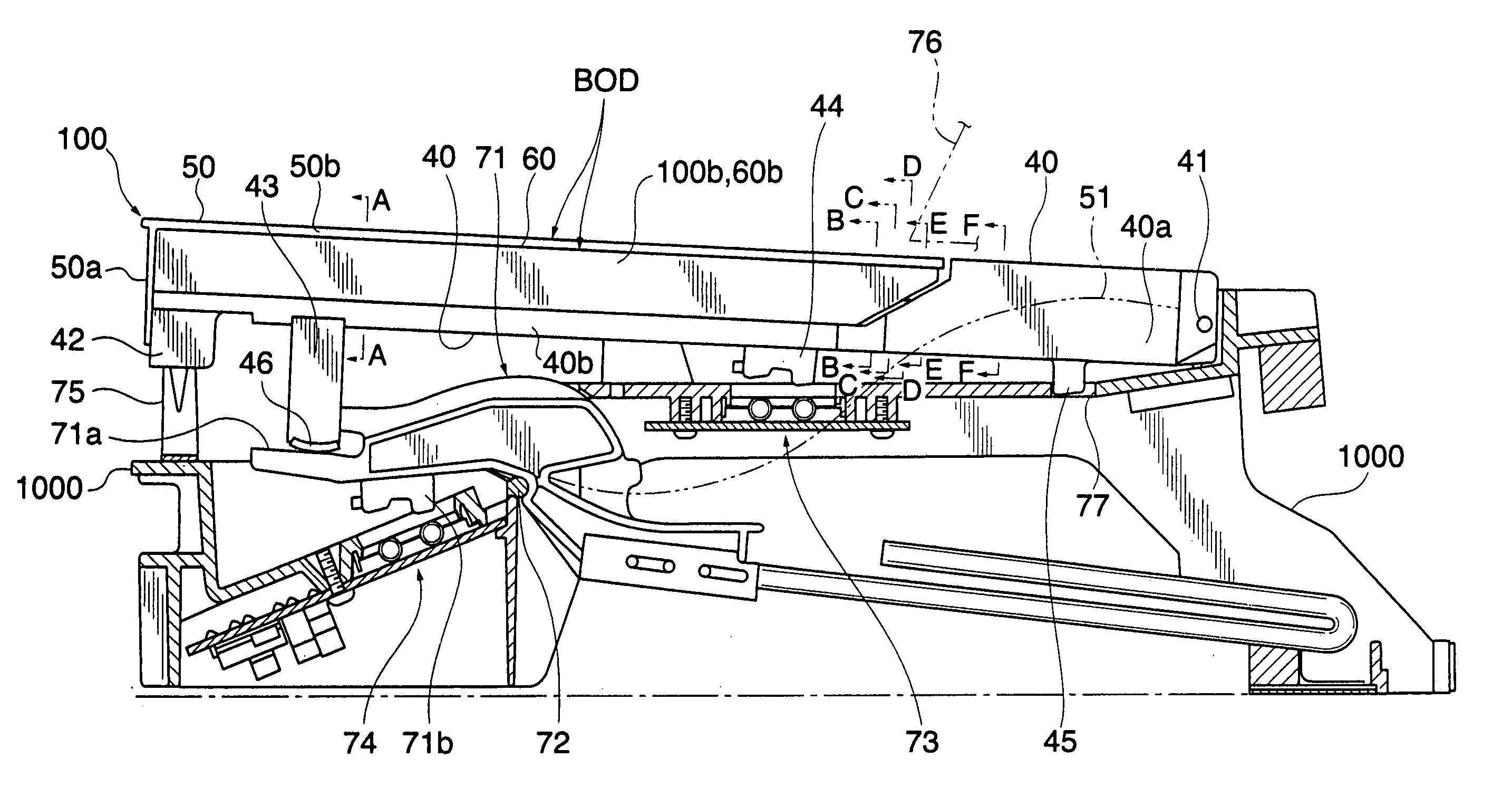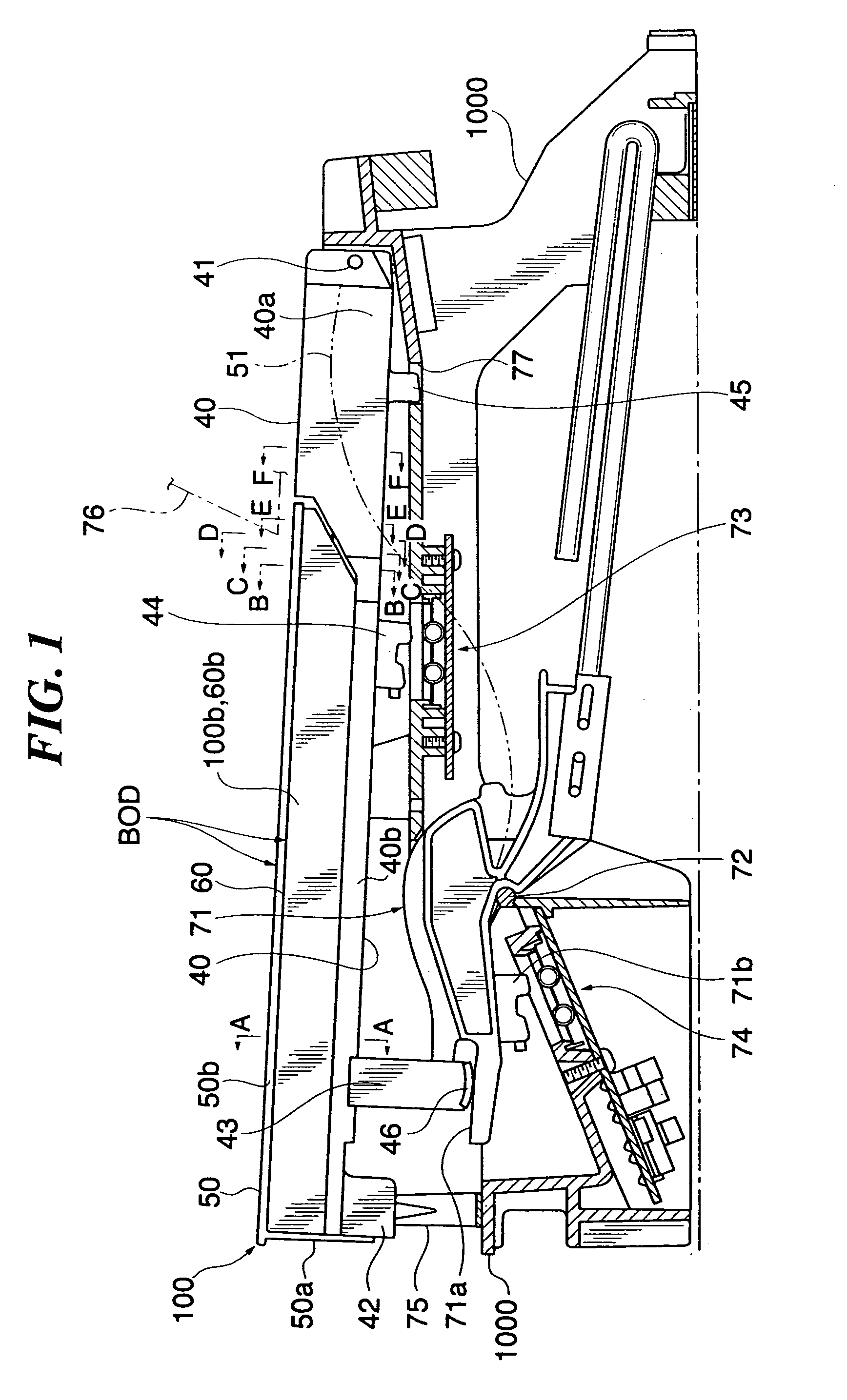Key structure and keyboard apparatus
a keyboard and key technology, applied in the field of key structure and keyboard apparatus, can solve the problems of reduced weight, difficult to secure the mounting space of functional parts, and high total height of the keyboard apparatus, and achieve the effect of increasing mounting freedom and excellent machinability
- Summary
- Abstract
- Description
- Claims
- Application Information
AI Technical Summary
Benefits of technology
Problems solved by technology
Method used
Image
Examples
first embodiment
[0123]FIGS. 3A to 3D are cross-sectional views of other examples of the key structure which show a cross-section corresponding to that of FIG. 2A of the above-described embodiment.
[0124] For example, FIG. 3A shows an example in which parts corresponding to the upper plate 50 and the key base 40 are formed integrally with each other and made of resin. More specifically, an upper plate 10a and a lower plate 10c are connected by a connecting part 10b, to form a shape of laterally buckled “H”. In this example, the wood part is comprised of divided parts 20L and 20R which are arranged on the opposite lateral sides of the connecting part 10b, to thereby form a key structure.
[0125] In the case of an example in FIG. 3B, a ridge-like protrusion 31a is formed on an upper plate 31 made of resin in a fashion extending downward therefrom, and a connecting part 32a and a lower plate 32b are formed integrally with each other and made of resin, with a groove-like recess 32aa formed in the top of ...
second embodiment
[0153] The key structure 200 is configured as a B key, for example. FIG. 6 is a right side view of the key structure 200. The key structure 200 is applied to a white key, but the construction of the key structure 200 may be applied not only to a white key but also to a black key. In the following description, a side of the present keyboard apparatus and the key structure 200 toward the player will be referred to as “the front side”.
[0154] The key structure 200 is constructed such that a wood part 67 made of wood is secured to the top of a key base 68 as a holding member, and further an upper plate 123 is secured to the wood part 67. The upper plate 123 is comprised of a front butt end member 81 as a front part, and an upper plate part 66 providing a key operating surface, which are made of a synthetic resin and formed integrally with each other. The front butt end member 81 and the upper plate part 66 may be formed in separate pieces. The wood part 67, which has approximately the s...
third embodiment
[0195] Although in the third embodiment, there is illustrated an example in which the holding member that fixedly holds the wood part is formed by the upper plate 125 and the key base 55 as separate bodies, this is not limitative, but the present invention is applicable to a configuration in which the wood part is held by the upper plate alone, or the wood part is held by a holding member comprised of an upper plate and a key base formed integrally with each other.
[0196]FIG. 11 is a partial cross-sectional view of a keyboard apparatus incorporating a key structure according to a fourth embodiment of the present invention. The fourth embodiment is distinguished from the third embodiment in the shape of the recess in the key structure, and hence in the shapes of the wood part and the key base. The two embodiments are identical in construction in the other respects.
[0197] As shown in FIG. 11, the key structure 500 according to the fourth embodiment is comprised of a key base 63 as the...
PUM
 Login to View More
Login to View More Abstract
Description
Claims
Application Information
 Login to View More
Login to View More - R&D
- Intellectual Property
- Life Sciences
- Materials
- Tech Scout
- Unparalleled Data Quality
- Higher Quality Content
- 60% Fewer Hallucinations
Browse by: Latest US Patents, China's latest patents, Technical Efficacy Thesaurus, Application Domain, Technology Topic, Popular Technical Reports.
© 2025 PatSnap. All rights reserved.Legal|Privacy policy|Modern Slavery Act Transparency Statement|Sitemap|About US| Contact US: help@patsnap.com



